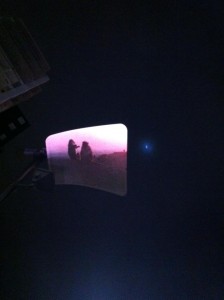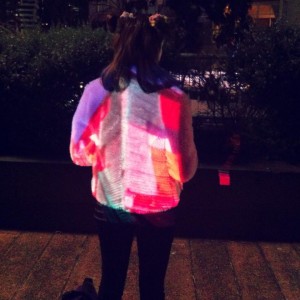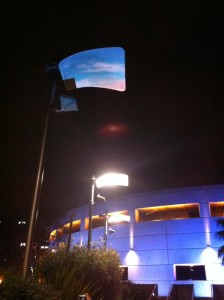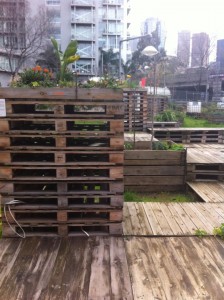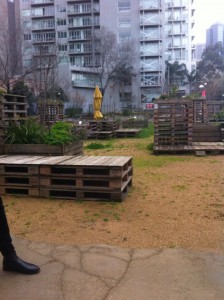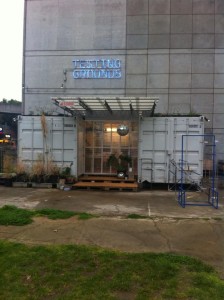As part of the night as Testing Grounds we broke off in groups to use the projector packs. This was a great artistic experience that allowed us to experiment with an unusual and contemporary art form that we dont usually have access to. We had backpacks with sound capabilities inside, they were connected to hand held projectors, which were attached to an iPhone and projected the images from the iPhone screen. We were able to project images and footage onto different surfaces around the city. We utilised stills, moving images and sound and documented our projections on a 3rd party camera. The night was aimed at activating a “non site” and the process of the projections was also, in a way, activating a blank space. We were transforming what once was a stagnant wall, bush, puddle or stairwell into an interactive art space. Overlaying this footage with different textures gave it new meaning. Rather then being played flat onto a white surface we were able to display the images onto broken and disjointed surfaces. We could reshape the images and warp them to give them a different interpretation. Combining the footage with the surroundings broke the barriers and boarders of a 2D computer or TV screen. Instead of viewing the material as a singular piece of art displayed within the parameters of a rectangular block we were able to merge it with its background and juxtapose the footage with its surrounding including the sky, the cityscape and the river.
Monthly Archives: August 2015
Testing Grounds
Last night we undertook our night class as Testing Grounds. The goal was to activate a site in a unique and novel place. To achieve this we organized a dinner party and BBQ at the venue. Testing grounds is an outdoor alternative art space that is malleable and allows artists to adopt the space and transform it in a way that suits them and compliments their work. The site is located on a corner block behind the art center. It contains different height mountains and clusters of wooden crates, umbrellas, planter boxes and a shipping container stage with a piano. We ran the BBQ with sausages and chips and set up a spread of food on one of the mountains of creates. We gathered on seats around the fire pits and enjoyed our share plates. I thought the night was very interesting in that it brought together a group of people who dont know each other that well in an event where we all contributed food and worked as a team to bring our services together and make the night happen. Everyone had their unique roles to play and it all came together like an artistic collaboration between a diverse mix of characters. The night itself was like a multidimensional artistic project. The event and documentation of the event made the night a multi layered night and turned the event into an artistic expression of creativity.
20/8/15
Todays class showed the remainder of the project brief 2 videos. I really liked how people had experimented with the representation of people i a place. My video was about the space itself but others had activated their sites and made them living, moving, breathing places with malleable and transformative elements. Some had shown a physical projection of a person in the place while others used movement of subject matter or the camera to depict a living person behind the camera in an almost documentary style. This had given their pieces another layer and additional level for the audience to relate to it. People start to consider not only the place itself but the ways in which it can be inhabited or utilised. Old discarded objects such as boots, bike wheels, spray cans and couches may seem like junk but also cause us to question where they came from, what their history is, how they came to be there and what stories and memories they contributed to. In my videos I wish I had been more creative with editing. I could have experimented with tempo more as well as altering colours, the speed of clips, rewinding clips, overlaying them and using other methods to make a more visual and artistic piece rather then a basic, straightforward documentation.
19/8/15
This lessons class we screened everyones project brief 2. After watching my piece I received some feedback. I need to experiment in not working in such a methodical and processed way.The work doesn’t always have to be a journey from a-b, it can be more experimental and creative. I grouped my footage and photography so all the similar subjects matter was placed side by side. Robbie suggested re composing it to juxtapose the images and give them different meaning. It was also suggested that I didn’t include the text. It was a bit “base” and in your face and maybe almost insulting to the audience to tell them what they are seeing. Robbie suggested making a poetic statement about each element such as “the body is a house of many windows” rather then “the windows” or “what we see is only a fraction of what really is” rather then “the view”. When watching my piece I found it very slow and tedious. The sound was on a repetitive loop, I tried to gradually build it up as the film progresses but it takes too long to build up. Robbie also mentioned maybe pairing different sounds with different scenery to create confusion. I was trying to combine stills and sound to create a multidimensional piece where the 2 senses had similarities and parallels without being as closely linked as a video production. For example when I showed the collection of images of stairs I paired it with the sound of myself walking down the stairs but the presence of a human was not there in the images. Also when I showed the final image taken from inside of the carpark of the outside world I paired it with a close up sound of a truck taking off but the truck was not present in the photo. I didn’t like how my sound was so repetitive. There was no rhythm to it, it was just a solid beat and there was one tapping noise in particular which became very irritating and overpowered the piece.
The Car Park Collection
My film “The Car Park Collection” is a combination of video, images and audio that depict the carpark as a “non place”. The footage was all taken in one particular carpark as I wanted to capture the same environment from different angles. Carparks are places of transition, they are not destinations in themselves. They are places of waiting, areas of the in-between where peoples cars sit silent and motionless while their owners are busy. The mood in the carpark is quite eeire and haunting. We are too preoccupied with our final destination that we are often to oblivious to notice this. When we spend a prolonged period of time in these places we are forced to reconsider them as solid locations rather then transient blank spaces. These spaces are given new meaning and purpose within the broader spectrum of our lives. The car park consists of rows and rows and levels, upon levels of cars parked side by side. The structure of the building winds round and round with each level like a mirror image of the one next before it. Its like a maze of concrete and its easy to understand why people get lost and struggle to relocate their vehicles. At times the carpark can be an empty place of stillness where you can hear every creak of the floor, crack in the plaster and drip of the drainpipes as well as the hustle and bustle of the outside world. This particular carpark was located in the centre of the CBD with much action going on around it yet the carpark itself sits there almost invisibly. All the signs in the park also enhance the hostile feeling of the environment. “No Standing” “No Parking” “No Exit” “Reserved”, these all create boundaries and limitations that are exclusive and shut off the outside world. The environment is clinical and hostile but at the same time calming and peaceful. It is a very urban setting with concrete, pavement, bricks, pipes, metal beams, fluorescent lights and monochromatic greys, blacks and whites. In my piece I chose to focus on a few key elements that comprise the carpark, these include ‘the levels, the textures, the corners, the lines, the windows, the view, the stairs and the exit’, all defining and unique elements to a car park. I wanted to keep my piece all with a similar, minimalistic aesthetic to highlight the simplicity and practicality of the carpark. I grouped my images accordingly and broke up each division using footage that captures the movement in the carpark. I like the unique shadows and lines that the cars make as they undertake their patterned and repetitive journey up the ramps. My final shot is taken from inside the carpark looking out. The low key lighting inside the carpark juxtaposes the bright and blown out light beaming in from the streets creating the effect that the carpark is the waiting place but the destination is the bright and busy outside world.
19/8
Working Process:
I have spent this week editing my carpark collection footage for “non site”. Usually when I am creating audio visual pieces I start with the audio and use that as a base. I then edit the footage to the sound cutting on the beats to create a rhythmic flow in the piece and unify the sound and visual as a whole. This time I arranged the footage by subject matter and then overlaid sound gradually building and adding recordings as the video progresses. In conclusion I felt that the piece was less cohesive then my work usually is. I am unsure whether it came together and united as a final piece in the way my work usually does. I would like to experiment with this different working process in future to refine it and see how others respond to it.
13/8
In todays class we discussed the breakdown of roles for our media excursion to the testing grounds. We looked at how each person can contribute and what the responsibilities will be of each group to come together constructively. I am excited to be creating this process from beginning to end and working on our individual tasks to create a final product. Robbie also spoke about using your mobile phones whilst on location. He explained that it is unprofessional and can loose you potential jobs or internships. Whether you are taking notes and doing something education wise or not people can automatically assume the worst of you when they see you on your phone not making eye contact or giving them attention. Note to self: be careful of this.
Week Review
Elements I want to capture in my work – Urban environments, patterns, repetition, leading lines, geometric shapes, cold, in between, travel, journey, movement/stillness, isolation/noise, places of waiting, transition, evolution, limbo, recreation, clinical, mundane, resting, out of use, in valid, unoccupied, separation/meeting/gathering
I would like to experiment with light and dark. Maybe shooting at night to capture the contrast of the dark night and bright lights of trains, lit up windows in buildings, street lights, at head lights. I would also like to experiment with a fish eye lens. This would capture the distortion and uneasy feel you can often experience when you spend an extended period of time in a ‘non place’. When you situate yourself in a place that is designed to be passed through and used as a temporary means of filling in the blanks between one place and another.
12/8
Inspiration for non place – Train tracks, green hills next to trains, construction sites, corridors, parking lots, park bench (south yarra hill), abandoned house, freeway overpass, train tunnel, scaffolding, church, caravan, trailer, garbage tip, airport, train station, tram stop, doctors office, train wheels (filmed from under the platform), stairwell, fire escape, elevator, NIKA, round about, footy oval (lit up at night), reservoir, wasteland, shipping containers, telephone tower, waiting in cues, the sky, prison, community garden, warehouse, hole in the wall coffee shops, match box houses, wooden building block houses, artist run initiatives.
Sou Fujimoto describes the contrast between what he calls the “nest” and “cave” type architectures. The nest is a type of structure created specifically with the people in mind. It is customised in order to achieve comfort and a sense of homeliness and practicality. The cave is often more of a landscape type product.This is an artistic and creative pursuit that allows people to unleash their curiosity and enginuity to adapt and transform the space into something that can be utilised or inhabited.
6/8
Todays lesson we went to Testing Grounds, an alternative run art space that allows creatives to exhibit their work in an artistic environment located between prestigious creative institutes including The NGV, The Art Centre, ACCA, The Malthouse and Hamer Hall. The site consisted of various crates stacked on top of one another, with gardens and plants dispersed around them. There was also a stage with a piano created out of a shipping container as well as a building with a bar and bathrooms. I found it really interesting to hear about the transformative effects of the weather. We spoke about an art exhibition at ACCA where a black bag floated up and down and became suspended in the air when it was heated by beams of sunlight. I like how the artist has let the elements of nature control the movement in the piece. When looking at Testing Grounds we also spoke about how the way a space is inhabited effects its feel. If a site is occupied with crowds it has a different essence to a sight that is deserted and empty. The last thing that caught my attention about Testing Grounds was the the different levels of the site and how that created different lines at varying heights.This was done to mimic the skyline and the city buildings. Also to facilitate discussion and gatherings in various clusters across the site.

